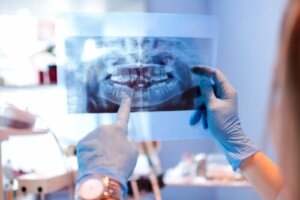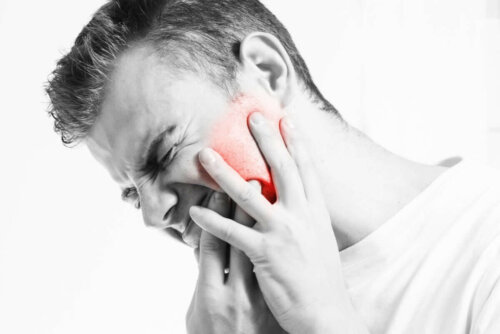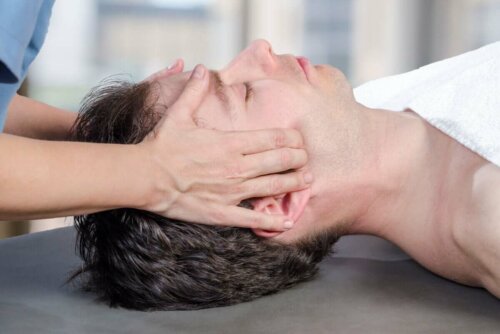Causes of Temporomandibular Joint Dislocation

Have you ever experienced temporomandibular joint dislocation? Usually, the several tendons and ligaments of the jaw keep it in place. However, they may fail and lead to this condition.
It occurs when one of the components of the joint, called a condyle, separates from the joint surface and moves over the temporal bone. It’s very common for this displacement to occur toward the anterior plane of the joint. However, it can move in any direction.
Reasons a jaw may be dislocated
Before getting into the possible causes of a dislocated jaw, it’s important to remember that it’s an uncommon pathology. In fact, several studies claim it only represents 3% of all dislocations. This is the main reason why there’s so much disagreement about its main cause.
What we can say for sure is that the causes will depend on the type of dislocation. The most frequent cause of an acute dislocation is trauma within minutes or hours of it.
In this respect, situations that involve a direct blow in this region could trigger jaw dislocation. However, don’t rule out that this injury may have occurred spontaneously. Thus, it can originate from various situations that involve opening the mouth a lot or keeping it open for a long time. For example:
- Yawning
- Laughing
- Vomiting
- Dental treatment
- Endotracheal intubation
Chronic recurrent is another type of temporomandibular joint dislocation. This is defined as a constant variation over time and involves the wear of the joint components. In this case, the most frequent causes of a dislocated jaw are spontaneous.
Similarly, the jaw can easily become dislocated in people with bruxism or some psychiatric disorder. This is due to the constant stress they subject their joint to.

Read about Jaw Pain: Have You Ever Suffered From It?
How do you recognize temporomandibular joint dislocation?
People with this lesion often have sudden pain in the jaw region, usually a kind of stab that limits movement. In addition, the joint snaps when trying to move it.
In short, the two main symptoms are pain and joint clicks. Also, you can notice the deviation of the jaw, either towards the healthy sides or forwards.
Many patients report not being able to close their mouths or achieve dental occlusion. However, these signs can vary. In fact, it evolves considerably in some patients in a matter of months because they didn’t feel any discomfort.
A doctor must use all the elements of the medical history to achieve a proper diagnosis. In this respect, they must investigate the characteristics of the pain and conduct a meticulous physical examination of the articulation. Often, an X-ray will be necessary as a confirmatory method.
What’s the treatment?
There’s medical treatment available for a dislocated jaw. So, you must consult a health professional if you suspect you might have this problem.
- In the case of acute dislocations, these can be reduced by the Nelaton or Dupuis maneuvers in most cases. These will vary if it’s a bilateral or unilateral variant, respectively.
- Both maneuvers have the same principle. A doctor will insert their thumbs into the oral cavity and place them on the lower molars. Then, they’ll press down while trying to raise the chin, which will generate a negative pressure or tension that’ll lead the mandibular condyle to its place.
- In some cases, especially with stressed patients, it’ll be necessary to use general anesthesia to facilitate the process. After performing the maneuver described above, they may need a bandage to stabilize the area for a few days.
- In cases of more severe acute or chronic recurrent dislocations, a surgical procedure may be necessary. However, the use of botulinum toxin has proven beneficial for avoiding surgery in certain cases.
- Finally, physiotherapeutic treatment will help regain the functionality of the joint. Thus, it’s recommended in cases of chronic recurrent dislocations.

Discover: Five Facts About Trigeminal Neuralgia, the Worst Pain in the World
What to do in the case of temporomandibular joint dislocation?
This condition isn’t too serious to your health but can be quite annoying and lessen your quality of life as it’s hard to go on with the usual routine. Thus, the first thing you must do is consult a health professional if you suspect a dislocated jaw.
The aforementioned maneuvers and appropriate treatment with analgesics and anti-inflammatories are the only ways to reverse the problem. Try to stay with the same doctor if it’s a recurrent condition so they’re familiar with your case and can indicate the most appropriate measures to follow.
All cited sources were thoroughly reviewed by our team to ensure their quality, reliability, currency, and validity. The bibliography of this article was considered reliable and of academic or scientific accuracy.
- Gómez de Terreros Caro G., Martínez Jimeno L., Gómez Gutiérrez I., Ramos Herrera A.. Luxación temporomandibular. Maniobra de Nelaton: exposición de un caso y revisión de la literatura. Sanid. Mil. 2020; 76( 1 ): 36-38.
- Alarcón-Ariza Diego Fernando, Zambrano-Jerez Laura Cristina, Sosa-Vesga Cristian David, Pardo-Parra Laura Marcela. Luxación de la articulación temporomandibular: apropósito de un caso y su diagnóstico diferencial. Medicas UIS. 2019 Dec; 32( 3 ): 49-54.
- Arista Apolinario, J. B. (2020). Enfoque fisioterapéutico de la luxación temporomandibular.
- Renapurkar, Shravan Kumar, and Robert A. Strauss. “Temporomandibular joint trauma.” Atlas of the oral and maxillofacial surgery clinics of North America 27.2 (2019): 99-106.
- Singh, Ishwar, et al. “Spontaneous temporomandibular joint herniation: a rare case.” Oral and maxillofacial surgery 21.1 (2017): 87-90.
- Larheim, Tore A., et al. “The role of imaging in the diagnosis of temporomandibular joint pathology.” Oral and Maxillofacial Surgery Clinics 30.3 (2018): 239-249.
- Prechel, Ulla, et al. “The Treatment of Temporomandibular Joint Dislocation: A Systematic Review.” Deutsches Aerzteblatt International 115.5 (2018): 59.
- Tatli, Ufuk, et al. “Comparison of the effectiveness of three different treatment methods for temporomandibular joint disc displacement without reduction.” International journal of oral and maxillofacial surgery 46.5 (2017): 603-609.
This text is provided for informational purposes only and does not replace consultation with a professional. If in doubt, consult your specialist.








